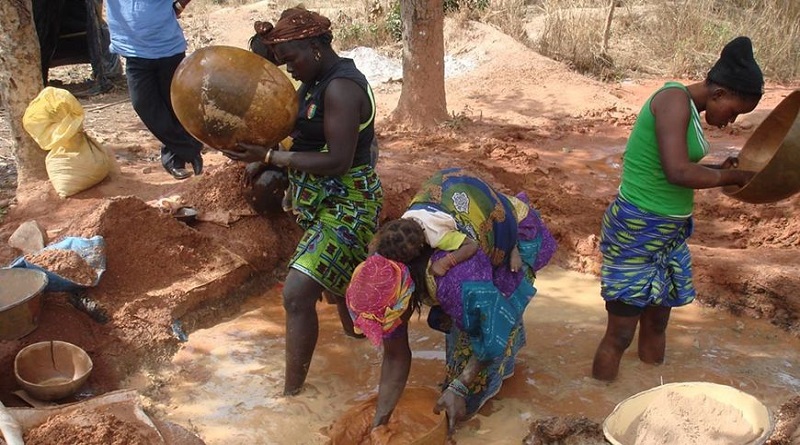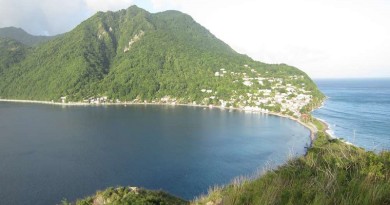Addressing mercury pollution from small scale gold mining
Mercury use in small-scale mining is common in some areas of the world, posing risks to human health and the environment. It is a practice often associated with small-scale mining, which tends to be poorly regulated due to the remote location of such mines.
Poorly regulated gold mining is spreading around the world. Every day, millions of artisanal and small-scale gold miners work extremely hard in often poor conditions and without the protective framework of formal labour market standards. By evening the vast majority have harvested only miniscule amounts of gold, if anything at all. But the economic incentives are still attractive. Since ancient times, gold has continuously been used as a source of long-term investment, and it has now found its way into modern technologies and industry, including computers, cell phones and medical equipment. Global financial turmoil has helped more than double the price of an ounce of gold from $500 to well over $1,000 over the past decade. Many poor people in rural areas have shifted their attention from agriculture to mining as a source of livelihood.
Such mining is now responsible for an estimated 20 per cent of all gold produced globally. It is scarcely regulated and standards are rarely enforced, especially as it is generally spread across remote areas that are difficult to access. It is plagued by illegal practices, often involving child labour – and by a big environmental footprint from deforestation, mercury pollution, and the degradation and sedimentation of watercourses.
Perhaps the most insidious aspect of this, both for people and the environment, is the use of mercury to recover minute gold fragments dispersed in soil and rocky sediments. A heavy metal found in the natural environment, mercury can become highly toxic when used in its elemental – or liquid – form. Liquid mercury evaporates even at relatively low ambient temperature, and can be dispersed over long distances by the wind. It binds with gold to form an amalgam, which is then heated to a high temperature to vaporise the mercury and extract the precious metal. This is often done with rudimentary equipment such as a blowtorch or – in the worst circumstances – over stoves in the miners’ own homes. Sometimes cyanide is used on the mining tailings to extract yet more gold, and it combines with the mercury to make compounds that are easily dispersed in water and taken up in food chains.
Breathing in mercury can damage the nervous, digestive, and immune systems. Ingesting it can cause the condition called Minamata Disease, after a coastal city in Japan where humans and animals ate mercury-laden fish and shellfish from the local bay. Its most notable symptoms are convulsions, loss of muscle coordination, and damage to vision, speech, and hearing. Pregnant women exposed to the toxic metal are susceptible to giving birth to babies with congenital diseases.
Artisanal and small-scale mining is the single biggest use of mercury worldwide, accounting for a third of its overall use. Among other things, the Minamata Convention aims to regulate and eliminate this practice. Using mercury in mining is inefficient, achieving only about 20-30 per cent efficiency in recovering gold compared to 60-90 per cent from alternative methods.
Artisanal and small-scale mining is the single biggest use of mercury worldwide, accounting for a third of its overall use. Among other things, the Minamata Convention aims to regulate and eliminate this practice. Using mercury in mining is inefficient, achieving only about 20-30 per cent efficiency in recovering gold compared to 60-90 per cent from alternative methods.
In 2013 the global community finally came together to address mercury pollution in a coordinated way, adopting the Minamata Convention on Mercury to control its production and use. The Global Environment Facility (GEF) was named as a financial mechanism to the convention, mirroring similar such mandates from other multilateral environmental agreements. In this capacity, the GEF is helping countries to achieve the objectives agreed under the Convention to address the risks that mercury poses to human health and the environment.
Artisanal and small-scale mining is the single biggest use of mercury worldwide, accounting for a third of the total and, among other things, the Convention aims to regulate and eliminate the practice. A recently approved programme, Global Opportunities for Long-term Development (GOLD) in the Artisanal Small Gold Mining Sector, is designed to help artisanal gold miners eliminate the use of mercury across several countries, and provides an example of concrete action.
Using mercury in mining is also very wasteful. It achieves only about 20-30 per cent efficiency in recovering gold compared to 60-90 per cent from alternative, much cleaner methods. So miners have a big financial incentive to switch, besides protecting their health. However, they often do not know about the alternatives and – if they do – they are unable to invest in them because they find it hard to borrow money from conventional sources. The GOLD programme is designed to address the situation by providing funds to countries with a sizeable gold mining sector, and where many artisanal miners still rely on mercury for gold extraction. GEF funding amounts to $45 million, and is expected to attract co-financing of more than $135 million from governments, international financing institutions, and private sector companies.
Governments will use the money to support mining communities by devising and implementing policies and regulations, introducing new mercury-free technologies, and designing and deploying ways of providing miners with loans to pay for them. Producers will be connected to international markets and supply chains which favour gold that uses less, or no, mercury in its extraction. The programme will build strong partnerships with the private sector, including major jewellers, electronic manufacturers, and gold refiners.
The GOLD programme is being managed by four implementing agencies: UN Environment, the United Nations Development Program, the United Nations Industrial Development Organization, and Conservation International. The first beneficiary countries are: Burkina Faso, Colombia, Guyana, Indonesia, Kenya, Peru, Mongolia and the Philippines. Through this programme, developing countries from three continents are coming together to shine light on artisanal gold and help to rid the world of the harmful effects of mercury.
This article first appeared in the March 2017 edition of UNEP’s Our Planet magazine, ‘Environmental Crime: Tackling the Greatest Threats to our Planet.’




